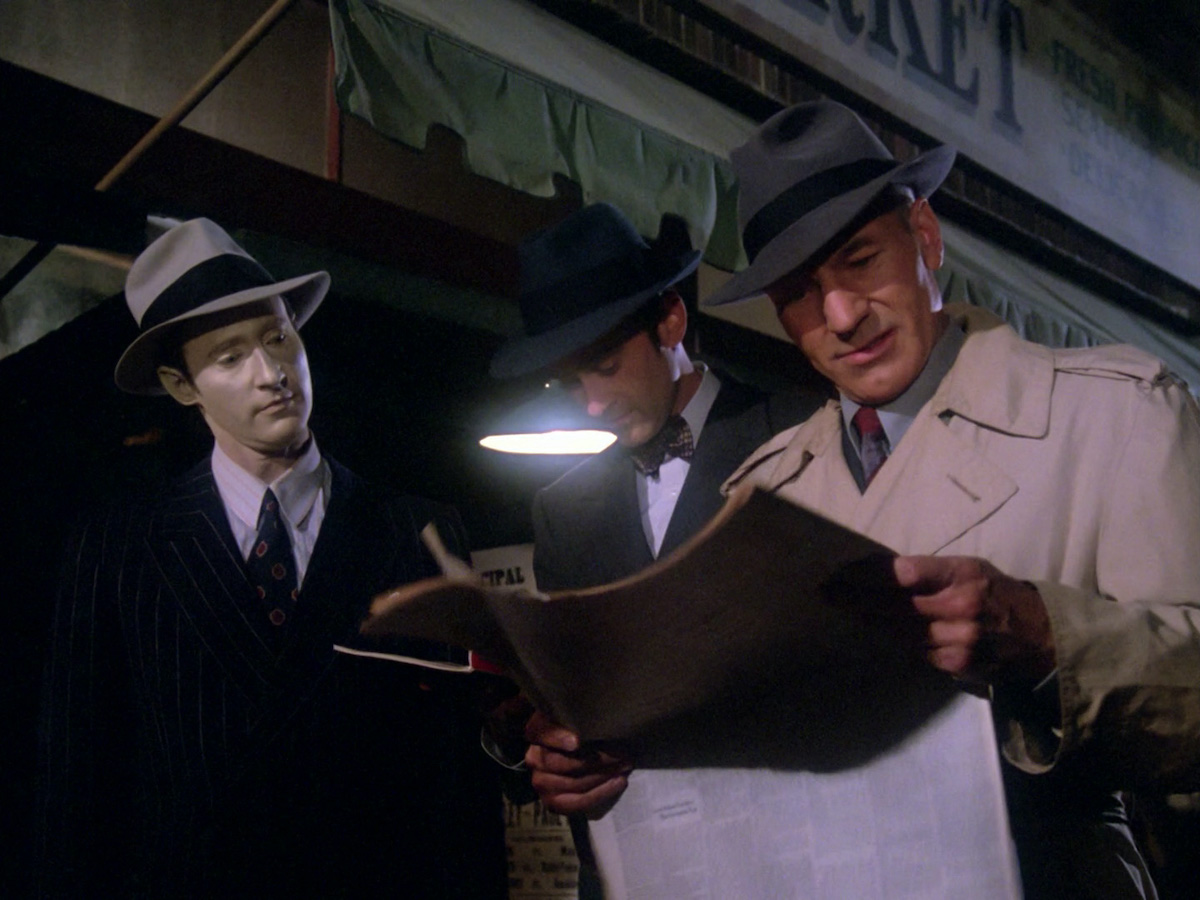“Civility, gentlemen. Always civility.”
Oh yeah. This one. Everyone speaks highly of “The Big Goodbye,” and it won all sorts of awards and regularly turns up on lists of the best episodes of Star Trek of all time. It kicked off The Next Generation’s fascination with the holodecks – their nature, their malfunctions (malfunctions so frequent one wonders how the technology ever made it out of beta-testing), and where the boundary lay between what is fantasized on the holodeck and what becomes functionally “real” – a fascination which would carry for the breadth of the series and beyond, and even metastasize into a full member of Voyager’s principal cast. But “The Big Goodbye” never captured my heart, particularly, nor did any of Next Gen’s noodling about the whims of holodeck-created reality. In watching the episode again, I can certainly see why it was so wildly popular; it’s very well made. At no point, though, do I retreat from the episode and wonder about any of the philosophical implications of the characters from the Dixon Hill novels (novels which are credited onscreen as the work of author Tracy Torme, a great first-and-second-season Next Gen writer for whom “The Big Goodbye” is his first solo writing credit) realizing in part that they are citizens of a computer simulation. The realization doesn’t take, for one thing: Cyrus Redblock might, with gangster-capitalist fervour, attempt to stride into the 24th century on a mission of plunder and opportunity, but one never gets the sense that the big meathead understood, even in glimmers, what the fuck he was taking on.
The episode becomes interesting to me only in 2 fragments, both of which take place after the Enterprise crew has left the holodeck, but while the program is still running; in one, Felix Leech pokes around Dixon Hill’s office while Captain Picard is out in the corridor saving the program, and in the other, we watch the lights literally go down on the Dixon Hill world at the end of the adventure. In both of these beats, I can conceive a bit of the fascination with the episode – what do the grumpkins and snarks get up to, when their masters/programmers/reasons for existence are gone? But the answer is the same, both times: a couple of seconds of independent reality, followed by electronic dissolution. To borrow from Data, nothing to write home about. There might be shades of warmed-over Blade Runner in McNary wondering aloud whether his wife and family would still be waiting for him, after Picard leaves the holodeck, but the episode never arrives at anything near so eloquent an existential point as Deckard confronting the origami unicorn and taking Rachel’s hand anyway.
The episode does introduce a key holodeck point, the notion of the safety failsafes, i.e. the apparently endlessly glitchy programming loop that prevents holodeck constructs from killing the humans within. We can also presume, based on the content of the episode, that holodecks themselves are almost entirely new at this point in the 24th century, given that Picard waxes rhapsodic about the texture of the Dixon Hill universe to his entire senior staff during a briefing. Within a month or two, this will all be old news, but I assume the really interesting part would be, say, a century later – what would Federation life be like when holodecks were perfect, the Doctor had been granted status as a Federation citizen, and consequently, the same rights might be conferred on all fantasy-driven life? Star Trek is grasping at a metatextual point here.
The only thing about “The Big Goodbye” that lingers with me after the fact are the offscreen references to an insectoid species called the Jarada, who are apparently real pains in the ass and would make good aggressors for some future Federation war. But they never arise again – nor do we even see their faces here.
Update: “The Big Goodbye” gets three Enterprises out of five.

My first presence on the internet was a Geocities site back in 1997, and having nothing better to do with it, I blogged about the new episodes of Star Trek: Deep Space Nine and Voyager that aired each week. Blogging The Next Generation is like that – for Star Trek: The Next Generation, every single episode, on blu-ray.
